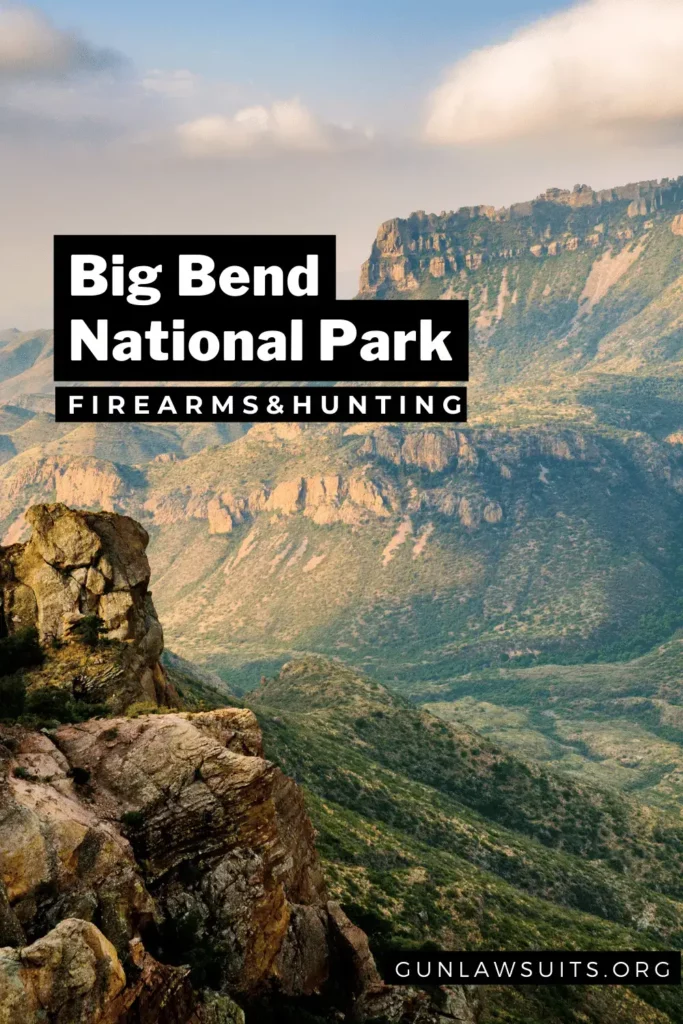Size: 801,163 Acres
Year Established: 1944
Annual Visitors: 581,000
Firearms Information in Big Bend National Park
A new “open-carry” of firearms law in the state of Texas took effect on September 1, 2021. In accordance with current Federal and state firearms rules, this law permits open carry of firearms within Big Bend National Park.
Despite the new open-carry law, these federal laws will still be prohibited and carefully enforced within Big Bend National Park:
- The discharge or use of a firearm
- Capturing, killing, or hunting animals
- Causing animal pain, distress, or death
- Causing damage to, defacing, or disrupting archaeological sites, natural landscapes, or natural resources
- Carrying guns on federal property (i.e. visitor centers, ranger stations, government offices, etc…)
- Threatening the safety of the public or triggering an emergency response (this may apply to brandishing of weapon).
You can learn more about Texas Gun Laws here.
Hunting in Big Bend National Park
Hunting and trapping are prohibited within Big Bend National Park.
To learn more about Hunting Laws in Texas, you can click here.

Additional Information About Big Bend National Park
Here in the midst of the Chihuahuan Desert, the Rio Grande snakes like a crimson ribbon. There are catfish in it, and it’s surrounded by mesquite and cottonwood trees. Some areas of Big Bend are surprisingly green despite receiving less than four inches of precipitation annually.
Because of their thin, highly forked tails, purple-throated Lucifer hummingbirds are drawn to the scarlet flowers of the ocotillo cactus, and yucca moths are drawn to the white blooms of the prickly yucca.
There are a wide variety of species that call this place their home, such as the roadrunner, the coyote, the collared peccary, and the tricolor heron. (Guests who are staying the night should be aware that there are scorpions in the area.)
It also has a large number of fossilized remains, such as those of the terrifying alligatoroid that was 40 feet long and the flying pterosaur that lived during the Cretaceous period. It also has the fossilized remains of saber-toothed cats and large mammoths, some of which you can find in the park’s Fossil Discovery Exhibit.
Best Time to Visit Big Bend National Park
The best time to visit Big Bend National Park is between the months of March to May and September to October.
Visitor Fees
$15.00 per person/cyclist for up to 7 days
$30.00 per vehicle for up to 7 days
$25.00 per motorcycle for up to 7 days
$55.00 for the Big Bend Annual Pass
Interesting in visiting multiple National Parks this year?
Consider the America The Beautiful Annual Park Pass.
This annual park pass to gets you and some friends into all U.S. National Parks for $80.
They also offer Senior, Military, and other discounts.
Visitor Centers
Panther Junction Visitor Center
Address
310, Alstate Ave, Big Bend National Park, TX 79834
Phone Number
(432) 477-2251
Hours of Operation
Daily 8:30 AM–5:00 PM
Be sure to check for seasonal closures.
Chisos Basin Visitor Center
Address
142 Chisos Basin Rd,
Big Bend National Park, TX 79834
Hours of Operation
Daily 8:30 AM–4:00 PM
Be sure to check for seasonal closures.
Castolon Visitor Center
Address
600, Ross Maxwell Scenic Dr,
Big Bend National Park, TX 79834
Hours of Operation
Daily 10:00 AM–4:00 PM
Be sure to check for seasonal closures.
Persimmon Gap Visitor Center
Address
Hwy 385 Main Park Rd,
Alpine, TX 79830
Hours of Operation
Daily 10:00 AM–4:00 PM
Be sure to check for seasonal closures.
Rio Grande Village Visitor Center
Address
National Park, 450 Rio Grande Road,
Big Bend National Park, TX 79834
Hours of Operation
Daily 9:00 AM–4:30 PM
Be sure to check for seasonal closures.

